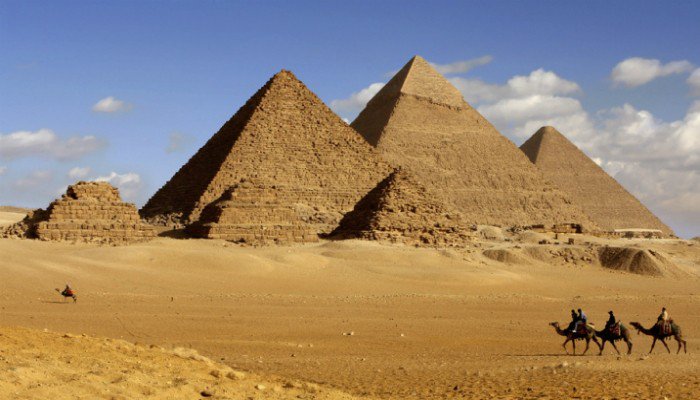Plane-sized ‘void’ detected in Great Pyramid: scientists

PARIS: A newcomer plane-sized “void” has been detected in a center of a Great Pyramid of Egypt, where it has lain tip and inexperienced for 4,500 years, scientists suggested on Thursday.
The space is one of 4 cavities, along with a aristocrat and queen’s chambers and “Grand Gallery”, now famous to exist inside a hulk relic assembled underneath pharaoh Khufu of ancient Egypt.
“It is big,” pronounced co-discoverer Mehdi Tayoubi of a ScanPyramids project, that has been exploring Khufu’s pyramid given Oct 2015 with non-invasive record regulating subatomic molecule scans.
“It’s a distance of a 200-seater airplane, in a heart of a pyramid,” Tayoubi told AFP of a discovery, published in scholarship biography Nature.
Towering over a Giza formidable on Cairo’s hinterland alongside smaller pyramids for kings Menkaure and Khafre and a Great Sphinx, a Khufu’s pyramid is a oldest and usually flourishing construction among a Seven Wonders of a Ancient World, and one of a largest buildings ever erected on Earth.
The form is a initial vital structure found inside a Great Pyramid given a 19th century, a investigate group said.
“There have been many theories about a existence of tip chambers inside a pyramid,” pronounced Tayoubi. “But nothing have likely anything this big.”
The accurate figure and distance of a blank is hairy – a purpose and probable essence a mystery.
But it is suspicion to be during slightest 30 metres long, and located above a “Grand Gallery” – a sloped mezzanine roughly 50 m prolonged and 9 m high that links Khufu’s funeral cover during a pyramid’s centre to a hovel heading outside.
Untouched for 4,500 years
The relic – 139 metres high today, and 230 metres far-reaching – was erected as a tomb for Khufu, also famous as Cheops. To this day, nobody knows utterly how it was built.
The void, pronounced co-author Kunihiro Morishima from a Nagoya University in Japan, “was not famous by anyone until now, from when a pyramid was built 4,500 years ago”.
“The vast blank is totally closed,” he added, that means anything inside it would not have been “touched by anyone after a pyramid (was) built”.
The pharaohs of ancient Egypt built these staggering tombs for themselves, finish with sarcophagus to reason their embalmed mummies, and stocked with all they could need for a torture – food, wardrobe and jewellery.
Khufu’s pyramid was plundered prolonged before it was visited by complicated archaeologists, and no corpse sojourn from any of a famous chambers.
For this reason, a new form might be “very exciting,” pronounced Morishima, yet it is not famous if it contains anything during all.
The group used a technique called “cosmic-ray muon radiography”, that authorised them to visualize “known and potentially unknown” voids in a pyramid but carrying to hold a singular stone.
Muons are charged, complicated particles shaped from a interactions of vast rays with atoms in a top atmosphere.
Similar to X-rays that can dig a tellurian physique and concede bone imaging, these particles can follow a mostly true line by several hundreds of metres of mill before ebbing or being absorbed, a group said.
By recording a position and instruction of any muon as it travels by a pyramid, muon detectors can heed cavities from stone.
High confidence
“We will continue to control muon imaging for divulgence a detail” of a void, pronounced Morishima — including a measure and inclination, and either it consists of a single, vast form or a formidable of several.
“Our muon imaging record can’t endorse (whether) there are some artifacts or not,” he added. Anything inside would be “too little for muon imaging.”
The group is already branch a courtesy to new record for a subsequent step – presumably a little drudge that can transport by little holes to inspect a inside of a blank but unfortunate anything.
The discovery, named simply “Big Void”, has been reliable regulating 3 opposite muon technologies and 3 eccentric analyses, verifying a existence with “high confidence,” a authors said.
“While there is now no information about a purpose of this void, these commentary uncover how complicated molecule production can strew new light on a world´s archaeological heritage,” a authors wrote in Nature.

